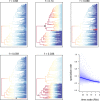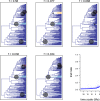Diversification of Angraecum (Orchidaceae, Vandeae) in Madagascar: Revised Phylogeny Reveals Species Accumulation through Time Rather than Rapid Radiation
- PMID: 27669569
- PMCID: PMC5036805
- DOI: 10.1371/journal.pone.0163194
Diversification of Angraecum (Orchidaceae, Vandeae) in Madagascar: Revised Phylogeny Reveals Species Accumulation through Time Rather than Rapid Radiation
Abstract
Angraecum is the largest genus of subtribe Angraecinae (Orchidaceae) with about 221 species. Madagascar is the center of the diversity for the genus with ca. 142 species, of which 90% are endemic. The great morphological diversity associated with species diversification in the genus on the island of Madagascar offers valuable insights for macroevolutionary studies. Phylogenies of the Angraecinae have been published but a lack of taxon and character sampling and their limited taxonomic resolution limit their uses for macroevolutionary studies. We present a new phylogeny of Angraecum based on chloroplast sequence data (matk, rps16, trnL), nuclear ribosomal (ITS2) and 39 morphological characters from 194 Angraecinae species of which 69 were newly sampled. Using this phylogeny, we evaluated the monophyly of the sections of Angraecum as defined by Garay and investigated the patterns of species diversification within the genus. We used maximum parsimony and bayesian analyses to generate phylogenetic trees and dated divergence times of the phylogeny. We analyzed diversification patterns within Angraecinae and Angraecum with an emphasis on four floral characters (flower color, flower size, labellum position, spur length) using macroevolutionary models to evaluate which characters or character states are associated with speciation rates, and inferred ancestral states of these characters. The phylogenetic analysis showed the polyphyly of Angraecum sensu lato and of all Angraecum sections except sect. Hadrangis, and that morphology can be consistent with the phylogeny. It appeared that the characters (flower color, flower size, spur length) formerly used by many authors to delineate Angraecum groups were insufficient to do so. However, the newly described character, position of the labellum (uppermost and lowermost), was the main character delimiting clades within a monophyletic Angraecum sensu stricto. This character also appeared to be associated with speciation rates in Angraecum. The macroevolutionary model-based phylogeny failed to detect shifts in diversification that could be associated directly with morphological diversification. Diversification in Angraecum resulted from gradual species accumulation through time rather than from rapid radiation, a diversification pattern often encountered in tropical rain forests.
Conflict of interest statement
The funder (Omaha’s Henry Doorly Zoo and Aquarium) provided support in the form of salaries for author [HNA]. This did not alter our adherence to PLOS ONE policies on sharing data and materials.
Figures





Similar articles
-
Characterization of Angraecum (Angraecinae, Orchidaceae) Plastomes and Utility of Sequence Variability Hotspots.Int J Mol Sci. 2023 Dec 22;25(1):184. doi: 10.3390/ijms25010184. Int J Mol Sci. 2023. PMID: 38203355 Free PMC article.
-
Progress in systematics and biogeography of Orchidaceae.Plant Divers. 2024 May 16;46(4):425-434. doi: 10.1016/j.pld.2024.05.002. eCollection 2024 Jul. Plant Divers. 2024. PMID: 39280975 Free PMC article. Review.
-
Phylogenetics and biogeography of Mascarene angraecoid orchids (Vandeae, Orchidaceae).Mol Phylogenet Evol. 2008 Mar;46(3):908-22. doi: 10.1016/j.ympev.2007.12.001. Epub 2007 Dec 14. Mol Phylogenet Evol. 2008. PMID: 18272406
-
Rapid radiation of angraecoids (Orchidaceae, Angraecinae) in tropical Africa characterised by multiple karyotypic shifts under major environmental instability.Mol Phylogenet Evol. 2021 Jun;159:107105. doi: 10.1016/j.ympev.2021.107105. Epub 2021 Feb 16. Mol Phylogenet Evol. 2021. PMID: 33601026
-
New phylogenetic insights toward developing a natural generic classification of African angraecoid orchids (Vandeae, Orchidaceae).Mol Phylogenet Evol. 2018 Sep;126:241-249. doi: 10.1016/j.ympev.2018.04.021. Epub 2018 Apr 16. Mol Phylogenet Evol. 2018. PMID: 29673694
Cited by
-
Slowly but surely: gradual diversification and phenotypic evolution in the hyper-diverse tree fern family Cyatheaceae.Ann Bot. 2020 Jan 8;125(1):93-103. doi: 10.1093/aob/mcz145. Ann Bot. 2020. PMID: 31562744 Free PMC article.
-
Characterization of Angraecum (Angraecinae, Orchidaceae) Plastomes and Utility of Sequence Variability Hotspots.Int J Mol Sci. 2023 Dec 22;25(1):184. doi: 10.3390/ijms25010184. Int J Mol Sci. 2023. PMID: 38203355 Free PMC article.
-
Progress in systematics and biogeography of Orchidaceae.Plant Divers. 2024 May 16;46(4):425-434. doi: 10.1016/j.pld.2024.05.002. eCollection 2024 Jul. Plant Divers. 2024. PMID: 39280975 Free PMC article. Review.
-
Polyploidy linked with species richness but not diversification rates or niche breadth in Australian Pomaderreae (Rhamnaceae).Ann Bot. 2025 Feb 19;135(3):531-548. doi: 10.1093/aob/mcae181. Ann Bot. 2025. PMID: 39441970 Free PMC article.
-
Afropectinariella (Vandeae, Orchidaceae), a new genus of the Angraecum alliance.PhytoKeys. 2018 Apr 13;(96):79-86. doi: 10.3897/phytokeys.96.23933. eCollection 2018. PhytoKeys. 2018. PMID: 29686500 Free PMC article.
References
-
- Goodman S, Benstead J. Updated estimates of biotic diversity and endemism for Madagascar. Oryx. 2005;39(1):73–7. 10.1017/S0030605305000128 - DOI
LinkOut - more resources
Full Text Sources
Other Literature Sources
Miscellaneous

